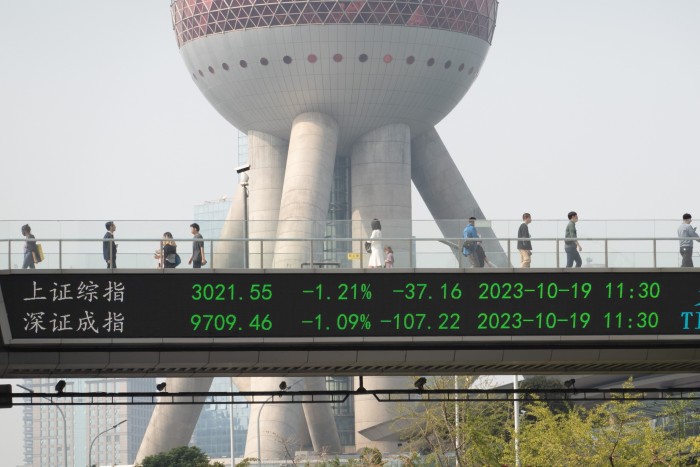Will India’s rise above China mean higher ETF returns?

Simply sign up to the Indian business & finance myFT Digest -- delivered directly to your inbox.
Just months after India overtook China as the world’s most populous nation, it also seized the Middle Kingdom’s mantle as the world’s fastest-growing large economy.
China’s economy is tipped by the World Bank to expand by just 4.4 per cent next year — its weakest rate since 1990, excluding the Covid pandemic — amid a property crisis, weak export growth and geopolitical headwinds. By contrast, India’s economy shows no sign of a slowdown amid a consumer boom: growth of 6.3 per cent is expected this year.
And global investors have noticed the change in mood music, with foreign investment being channelled out of China and into India, in anticipation of richer pickings.
Roughly half of the $250bn-$300bn of overseas money that flooded into Chinese bonds, because of their inclusion in various indices, since 2019 has now exited, JPMorgan estimates. At the same time, foreign ownership of Chinese equities has fallen by more than $100bn.
In India’s equity market, money has been heading in the opposite direction. There were $15.5bn of foreign inflows in the first eight months of this year, with just another $1.5bn needed to erase last year’s record outflows, says Dina Ting, head of global index portfolio management at Franklin Templeton.
Overseas investors’ enthusiasm may spread to the country’s fixed income market next. India is due to be added to the most widely followed emerging market bond index next year — a move that Morgan Stanley forecasts will drive $30bn of foreign inflows into its government bond market.
“One economy has cyclical and structural tailwinds, the other has cyclical and structural headwinds,” says Anuj Arora, chief investment officer of the emerging markets and Asia-Pacific equity team at JPMorgan Asset Management. “And, because it’s a [domestic] consumption boom, it’s pretty immune to [what happens in] the rest of the world,” he adds, referring to the dynamics in India.
“This is a big-picture shift and people are seeing these inflection points,” says Rahul Sen Sharma, co-chief executive of Indxx, a provider of indices that underpin $15bn of exchange traded fund assets.
“India can fill the gap that China’s slowdown is creating,” he adds. “India’s demographic bulge started much later than China’s and is forecast to continue until 2050 [so there is] a young, growing workforce versus a declining, ageing population in China. Indian consumption is expected to double from $2tn in 2022 to $4.9tn by the end of 2030. As such, it will surpass China to earn its title as ‘EM darling’.”
For investors seeking passively managed exposure to this economy, the largest India-focused ETF is the US-listed $6bn iShares MSCI India ETF. It is a market cap-weighted fund with 122 large and mid-cap constituents. A $2.3bn Ucits version is also available in 16 European countries.
Rival offerings in the US include the WisdomTree India Earnings Fund, which weights companies based on their prior year earnings, and the Franklin FTSE India ETF, which tracks the large and mid-cap FTSE India Capped Index.
A Ucits version of the latter is listed across Europe, as well as Mexico. Europe also boasts the Amundi MSCI India II Ucits ETF, which tracks the same index as the iShares ETF, and the L&G India INR Government Bond Ucits ETF, for those interested in fixed income.
However, the investment thesis may not be as clear-cut as the GDP growth rates suggest. One issue is whether investors thinking of switching country have already missed the boat — India’s better story may now be largely priced in to assets there.

For example, the iShares MSCI India ETF has already returned a cumulative 8.4 per cent over the past year, 48.9 per cent over five years, and 126.6 per cent over the past decade. By contrast, the iShares MSCI China ETF has returned 4.6 per cent, minus 21.7 per cent and 11.5 per cent, respectively, over the same time periods.
As a result of these equity market movements, India’s now trades on a price/book ratio of 3.6 and a forward price/earnings ratio of 22, according to JPMorgan’s Arora — far higher than the 1.3 times price/book and a p/e ratio of 9 times next year’s earnings in China.
“These [Indian] valuations have been reached four times in the past 30 years, and each time they resulted in a five-year period of stagnation,” points out Arora.
Investors should also be wary of pinning too much hope on economic growth, long-term studies suggest.
A 2013 study by London Business School academics found a negative correlation between economic growth rates and equities’ returns, suggesting that investors would have been better off investing in the most sluggish economies. The academics behind the study, Elroy Dimson, Paul Marsh and Mike Staunton, speculated that the underlying dynamic is that investors appear to routinely overpay for growth.
Accessing any gains that are made can also be less than straightforward for foreign investors in Indian stocks. They are subject to capital gains tax of 15 per cent on positions held for less than a year, or 10 per cent if held for longer. This will be a factor in the iShares MSCI India ETF lagging behind the 153.7 per cent return of its benchmark index over the past 10 years.
The Indian government maintains an array of foreign ownership limits on many stocks, too — potentially complicating the ability of index managers to construct well-diversified benchmarks.
“We have to look at foreign-ownership limits when we are building our products,” says Indxx’s Sharma. “There are so many companies that have limits, so you have to look at each company on a standalone basis. If there is a lot of interest in a particular company, then it becomes a problem.”
Despite this, Sharma is optimistic that long-term trends are moving in India’s favour. “China’s rise took a number of decades, from [President Richard] Nixon’s visit in the 1970s, and with increased speed in the 1990s. That has got us where we are 25 years later,” he says. “The changes [in India] are going to take a good amount of time.
“For much of civilisational history, China and India were a large part of global [gross domestic product]. That only changed in the 1600s. What we are seeing is a shift back to that.”
Comments